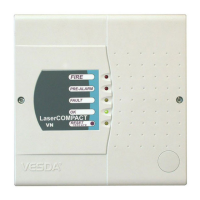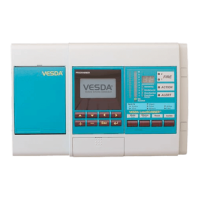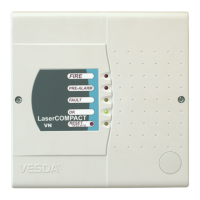Installation Sheet - OSID Smoke Detection System
Detach Detector Mounting Bracket from Front Cover.
• To detach the unit from the Mounting Bracket (A), open the front cover and with a screwdriver push the lip
backwards to then slide the unit up to detach from the Mounting Bracket
• To provide cable access to the Termination Card of the Imager or externally-powered Emitter, use a screw
driver as shown in (B) to remove the Front Cover (C) from the main assembly. Remove the cut-outs from
the back or top of the main assembly by using a sharp blade to cut around the circular discs.
Mounting via Mounting Bracket (Option 1):
Please follow the instructions in this step if you have chosen to secure the detector component to the mounting
surface using the supplied mounting bracket. If mounting directly to the mounting surface, please skip to Option 2.
• Using the screw holes of the bracket as a template, mark the installation point (A).
• Use appropriate fasteners to x the mounting brackets to the mounting surface. It is recommended that
starwashers are used to prevent the brackets slipping.
• Attach the rear assembly of the component onto the mounting brackets (B)
• When mounting the Imager units onto the brackets, ensure that the ribbon cable at the back of the optical
sphere does not get caught between the unit and the bracket, as movement of the optical sphere may pull
the ribbon cable out of the connectors.
2
3
4
This installation sheet provides information on how to install the OSID Smoke Detection System. Full product information
can be found in the OSID Product Guide (Document No. 15204) available at www.xtralis.com.
The OSID system consists of an Imager and up to seven Emitters. Although both components have the same
mechanical housing, Imagers are distinguished by the presence of the two status LEDs on the underside of the device.
OSID Installation Kit (OSID-INST) are sold separately. They are required for all product installations. Please contact your
local Xtralis supplier for ordering information.
Determine the positions of the Imager and Emitter Components.
Make sure that the intended mounting locations meet the following criteria:
• Emitter spacing must comply with local codes and standards (B)
• Emitters must be located within the Field of View (FOV) of the Imager (A)
• Clear path between the Emitter and Imager
• Mounted well above the head-height of people and obstructions
• Avoid direct sunlight onto the units
When securing the detector to the mounting surface, mount the Imager rst so that the approximate edges of its
eld of view can be determined. This will show the region in which the Emitter units can be located.
The Imager and Emitter/s should be placed within a distance (H) below the ceiling. This value will vary
according to regional specications, geometry, and specic requirements for the installation. The distance (H)
for at ceilings and basic spacing requirements (S) is shown in the following table.
Standard Distance from Ceiling (H) Maximum Spacing (S)
NFPA72 - 18.3 m (60 ft)
AS1670.1 25 to 600 mm (1 to 23.6 in.) 14 m (45.9 ft)
BS5839.1 25 to 600 mm (1 to 23.6 in.) 15 m (49.2 ft)
GB50166 300 to 1000 mm (11.8 to 39.4 in.) 14 m (45.9 ft)
For full information on spacing requirements, please refer to your local codes and standards.
1
Mounting directly to the mounting surface (Option 2):
Follow this step if you have chosen to secure the detector directly onto the mounting surface without using the
supplied mounting bracket.
• Pre-drilled mounting screw holes have been provided (three places) (A).
• Using the drilled screw holes as a template, mark the installation point.
• Use appropriate fasteners to secure the detector component to the mounting surface.
A
B
C
Y
Y
X
X = HORIZONTAL FOV
Y = VERTICAL FOV
X°
A
B
H
A
B
A
B
Congure System via the DIP Switches on the Termination Card of the Imager:
A. Fire Alarm
Thresholds
(Switch Pair A,
Switch no. 1 & 2)
00 Not Congured (Trouble / Fault
signaled)
C. Alarm Latching
(Switch C,
Switch no. 6)
0 Non-Latching
10 Level 1 - 20% (0,97 dB) Highest
Sensitivity
1 Latching
01 Level 2 - 35% (1,87 dB) D. Dust Rejection
(Switch D,
Switch no. 7)
0 Disabled
11 Level 3 - 50% (3,01 dB) Lowest
Sensitivity
1 Enabled (Increased tolerance to dust events resulting
in fewer Faults signaled)
B. Number of
Emitters
(Switch Group B,
Switch no. 3, 4 & 5)
000 Not Congured (Trouble / Fault
signaled)
100 1 Emitter present E. Industrial Mode
(Switch no. 8)
0 Disabled
010 2 Emitter present
110 3 Emitter present 1 Always Enabled (Provides increased tolerance to
condensation, water vapours and dust events)
001 4 Emitter present
101 5 Emitter present
011 6 Emitter present
111 7 Emitter present F. Enhanced Mode
(Switch no. 9)
0 Disabled (EN54-12 Approved 6dB Alarm enabled) for
UL 268 Approved units, set to 0
1 Enabled (Not EN54-12 approved. Object intrusion
producing 6dB attenuation gives a Fault instead of
Alarm)
G. Industrial Mode
Trigger
(Switch no. 10)
0 Disabled
1 Trigger (Reset input acts as a switch for enabling the
Industrial Mode. When 24V applied to the Reset Input,
there is increased tolerance to condensation, water
vapours and dust events)
1
2
7643 5 98 10
A B C D
E
0
1
SW1
G
F












